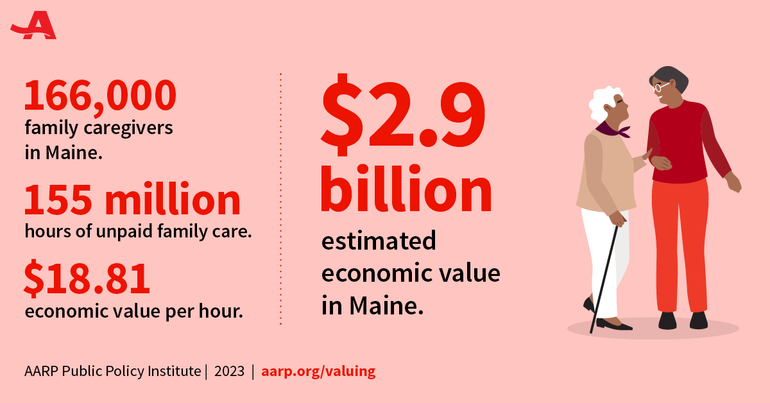
AARP: Maine family caregivers provided $2.9B in unpaid care in 2021
 Courtesy / AARP Maine
Unpaid family caregivers have a big economic impact in Maine, as detailed in this infographic.
Courtesy / AARP Maine
Unpaid family caregivers have a big economic impact in Maine, as detailed in this infographic.
Maine has 166,00 family caregivers who provided $2.9 billion in unpaid care in 2021, new data from AARP shows. The figures were released in the latest update to the organization's "Valuing the Invaluable" series of reports.
The $2.9 billion figure for unpaid care of parents, spouses, partners and other loved ones was based on 155 million combined hours of care provided, valued at $18.81 an hour.
That compares to an economic impact of $2.2 billion in 2017, as documented in the previous report.

“Family caregivers play a vital role in Maine’s health care system, whether they care for someone at home, coordinate home health care, or help care for someone who lives in a nursing home,” said AARP Maine State Director Noël Bonam. “We want to make sure all family caregivers have the financial, emotional and social support they need, because the care they provide is invaluable both to those receiving it and to their community.”
Nationwide, the unpaid work paid by family caregivers is valued at an estimated $600 billion, according to the report. That amounts to a $130 billion increase in unpaid contributions from family caregivers since the previous barometer was released in 2019.
Aging population
The $600 billion nationwide economic impact is more than all out-of-pocket spending on health care in the United States in 2021, the AARP notes in its latest report.
The study also highlights trends in family caregiving, explores the growing scope and complexity of caregiving and highlights actions needed to address the financial, social and emotional challenges of looking after loved ones.
By 2034, adults age 65 and older will outnumber children under the age of 18 for the first time. The share of available family caregivers is projected to continue shrinking relative to the number of older adults who will potentially need long-term care.
In addition, family caregivers will continue to face the dual demands of employment and caregiving responsibilities, which often include caring for an older adult and a child or children simultaneously.
“Family caregivers are the backbone of long-term care in this country,” said Susan Reinhard, senior vice president, of AARP Public Policy Institute and a lead author of the report.
“The care they provide is invaluable to those receiving it. But this is not just a family issue. It impacts communities, employers and our health and long-term care systems,” she added. “We must treat family caregivers as the valuable resource that they are by providing them the support they need to care for loved ones while also caring for themselves.”
More information
Find the full report and methodology here. Resources and information on family caregiving are available here.
we are both disabled. Don't qualify for aid - need to have this idea of caretakers recouping time and money to actually directly helping us. We just keep muddling along by ourselves.














1 Comments